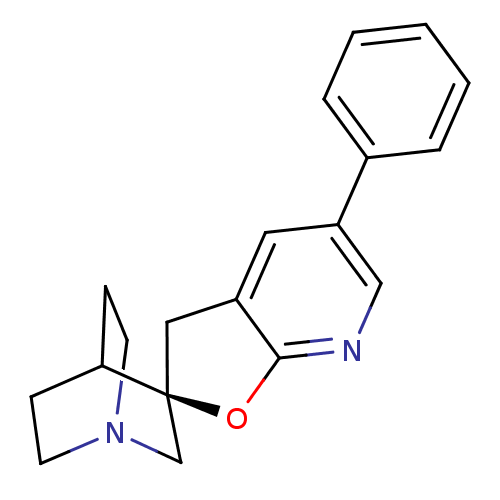BDBM50173944 5'-phenyl-(2'R)-spiro[4-azabicyclo[2.2.2]octane-2,2'-furo[2,3-b]pyridine]::CHEMBL195345
SMILES C1c2cc(cnc2O[C@]11CN2CCC1CC2)-c1ccccc1
InChI Key InChIKey=GIRLVGYIIVFTLI-IBGZPJMESA-N
Data 4 KI
Activity Spreadsheet -- Enzyme Inhibition Constant Data from BindingDB
 Found 4 hits for monomerid = 50173944
Found 4 hits for monomerid = 50173944
TargetNeuronal acetylcholine receptor subunit alpha-7(Homo sapiens (Human))
Bristol-Myers Squibb Pharmaceutical Research Institute
Curated by ChEMBL
Bristol-Myers Squibb Pharmaceutical Research Institute
Curated by ChEMBL
Affinity DataKi: 2nMAssay Description:Binding affinity to human alpha7 nAChRMore data for this Ligand-Target Pair
Target5-hydroxytryptamine receptor 3A(Homo sapiens (Human))
Bristol-Myers Squibb Pharmaceutical Research Institute
Curated by ChEMBL
Bristol-Myers Squibb Pharmaceutical Research Institute
Curated by ChEMBL
Affinity DataKi: 2nMAssay Description:Binding affinity to 5-HT3A receptor (unknown origin)More data for this Ligand-Target Pair
TargetNeuronal acetylcholine receptor subunit alpha-7(Homo sapiens (Human))
Bristol-Myers Squibb Pharmaceutical Research Institute
Curated by ChEMBL
Bristol-Myers Squibb Pharmaceutical Research Institute
Curated by ChEMBL
Affinity DataKi: 3.10nMAssay Description:Binding affinity towards human nicotinic acetylcholine receptor alpha 7 expressed in GH4C1 cell using [3H]methyllycaconitineMore data for this Ligand-Target Pair
Affinity DataKi: 73nMAssay Description:Binding affinity for human 5-hydroxytryptamine 3 serotonin membrane receptor using [3H]GR-65630More data for this Ligand-Target Pair
